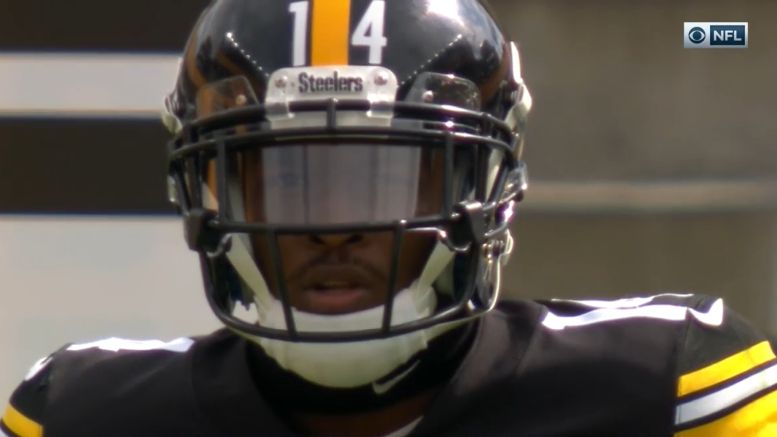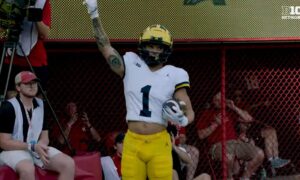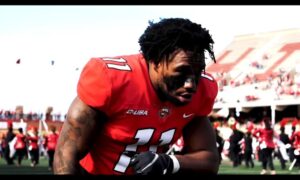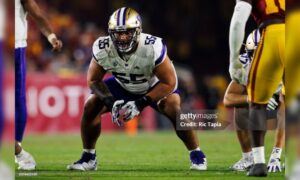Ray-Ray McCloud was a gem of a free agent find for the Steelers in 2020 (he had 944 combined yards on kick and punt returns, 20 receptions for 77 yards, and four rushing attempts for 65 yards), with the team signing him during training camp. While he did have some miscues, he proved to be both a reliable and explosive kick and punt returner overall, and he even played a decent number of snaps on offense in a gadget role.
In the 2020 Randy Fichtner led quick-passing attack, JuJu Smith-Schuster (5.5 aDOT), Diontae Johnson (7.9 aDOT), and Ray-Ray McCloud (-1.5 aDOT), were all given targets close to the line of scrimmage, resulting in their low average depth of target (a.k.a. aDOT) numbers. While Smith-Schuster and Johnson should have been utilized downfield more in 2020, McCloud isn’t a full-time receiver (he was on the field for 165 total offensive snaps last year. In his career, he has received just 28 targets, catching 25 of them), so it’s tough to tell if he can even operate as more than just a gadget piece in the offense.
That’s what this film study is focusing on. Fellow WR JuJu Smith-Schuster recently said that Ray-Ray McCloud could play a larger role in 2021, especially from the slot. Adding more fuel to the fire, wide receivers coach Ike Hilliard called McCloud “versatile” at the team’s mini camp.
With the support of both his teammates and coaches inspiring him to carve out even more of a role in 2021, could we see McCloud play over 165 offensive snaps (his 2020 total), and will he be targeted further down the field? Let’s go to the film to find out.
Tape Breakdown
McCloud was utilized almost exclusively as a gadget player for the Pittsburgh Steelers in 2020. While he is dangerous with the ball in his hands (5.3 YAC per reception in 2020), defenses rarely had to worry about guarding him deep due to the way Pittsburgh employed him (he had a negative aDOT on the season and his longest catch on the season went for just 13 yards). That made the Steelers’ play calling with him on the field more predictable, and in turn, easier to defend. In order to remedy that issue, McCloud needs to prove he can operate down the field.
I’m going to get into McCloud’s potential as a threat beyond the line of scrimmage in a bit, but first let’s get a refresher on what positives McCloud provided to the offense in 2020. If the Steelers are being truthful about his role expanding in 2021, McCloud’s usage in 2020 could give us a road map picture as to how Matt Canada could use him on jet sweeps, end arounds, reverses, screens, RPOs, etc., plus the possible downfield role (which as noted, I’ll discuss later in the article).
In this clip, McCloud receives the end around toss after the Steelers fake a counter run (RB James Conner’s effort sells it well). The linebackers bite based on the look of the counter, so McCloud is off to the races field side with a convoy of blockers in front of him. While he is tracked down from behind by good effort/angles from a couple Philly defenders, this is the type of explosiveness that McCloud can provide to jump start the offense. Matt Canada should have a field day when scheming up how to use McCloud in a similar gadget role moving forward.
This next clip displays a jet motion touch pass that McCloud is able to take for a first down. Getting McCloud moving laterally with a full head of steam is a great way to either generate needed yards in short yardage situations, or to influence the defense in order to pull defenders out of position for an interior run handed off to the running back. This type of touch pass is something the Steelers’ QBs and WRs were seen working on at OTAs, in order to get their timing down. Media members who were present snapped videos. Based on that information, expect to see more of this type of play in 2021 and beyond (as long as it stays successful).
This clip showcases McCloud’s longest reception of the 2020 season. As the furthest receiver off of the line in the tight, trips bunch set at the bottom of the screen, McCloud has a free release to which he quickly cuts outside and gets his head around to look for the pass. Big Ben puts the throw behind him, but McCloud’s able to contort his body by spinning to adjust to the throw and snag the ball in the air. He keeps his balance and looks for extra yards after the catch, moving the sticks in the process and finishing through contact.
The previous three clips provide a snapshot of how McCloud was used in 2020 (and how we might see him used in 2021). Now let’s discuss whether or not he can offer the offense even more if given an expanded route tree. Before getting into more clips however, there’s an important question that needs to be asked:
Who’s Coming Off The Field?
So, it’s apparent that McCloud was used in a gadget role in 2020 and can provide the offense a big play threat when given manufactured touches, but can he really provide more than that?
If McCloud is going to play more in 2021, he’ll be taking snaps away from either JuJu Smith-Schuster, Diontae Johnson, Chase Claypool, or James Washington. In my opinion, I don’t think taking one of the top three WRs (JuJu, Johnson, Claypool) off the field for McCloud is in the Steelers’ best interest, and I don’t see the Steelers deciding to run more empty sets (00 and 01 personnel) just to get McCloud on the field (although that’s probably his most realistic path to more playing time). Their best plan of action when utilizing three receiver formations should be Johnson at the X, Claypool and JuJu rotate in the slot on early downs, and JuJu in the slot for third downs with Claypool at the Z. If McCloud were to eat into some of James Washington’s snaps (although Washington has produced at times), I wouldn’t complain, but only if he’s going to be sent downfield more.
If McCloud is used in the exact same fashion that he was last year, the offense becomes way too predictable with him on the field. His speed (he ran a 4.53 40-yard dash at the 2018 scouting combine, which isn’t a true “burner” time), contact balance, and big-play RAC ability can be utilized to stretch the field, so if he’s given snaps he needs to be put into position to make plays. However, that’s easier said than done. McCloud has to show that he can be an effective route runner with reliable hands and consistency in contested catch situations. Training activities and preseason games will give Steelers’ personnel an idea of how much McCloud has progressed as a WR.
With all that being said, let’s take a look back at McCloud’s ability to operate vertically.
Since McCloud has been in the league for three years (and has only played sparingly) spending just last year with the Steelers, there isn’t much tape on him operating as a downfield receiver. So, I went back to watch some of his college tape from his time at Clemson in order to see him working deeper routes.
This first clip demonstrates that he has the ability to win downfield as more than just a gadget guy. McCloud is lined up off of the line field-side. At the snap, he eyes up the DB (current Los Angeles Chargers CB Brandon Facyson) before putting his right foot in the ground and taking off towards the outside with a speed release. The DB is able to stay in phase, but the QB delivers a back-shoulder throw. Here’s what’s important about this clip; McCloud is able to fight through contact with the DB, track the throw, then go up and high point it. After getting his hands on the football, McCloud immediately begins to bring it into his chest while spinning away from the defender, denying the defender a chance to play through his hands. Impressive catch for a guy McCloud’s size, especially considering that he’s working against a bigger DB.
Now, I didn’t include this clip to say the Steelers should be throwing fades to McCloud every time he’s on the field (it’s not a good idea at all), and while it isn’t a rep from the NFL level, the clip does show that McCloud can win in contested catch situations (his ball tracking skills and hands stand out in this clip), even if the tape is limited. That’s one positive in McCloud’s favor, if the Steelers are truly going to use him down the field in 2021.
Here’s another example of McCloud winning downfield in college. Lined up at the top of the screen field-side, McCloud creeps up to the defender before taking off to the outside with a speed release. After stacking the DB, he gets his head around, while keeping the DB a little under an arm’s length away with his hands, in order to maintain space to make the over-the-shoulder catch by the sideline. He holds on to the catch all the way to the ground, despite a last-second attempt by the DB to dislodge the football. Another catch through contact.
Here’s yet another college example of McCloud beating tight coverage vertically. He (bottom of the screen) takes a hop inside so that he has more room to shoot outside for his release. After releasing outside, the QB immediately lobs him an over-the-shoulder pass that McCloud is able to track and secure. In watching his college tape, I noticed that McCloud does a good job of being physical in the stem of his routes, utilizing his hands well to fight for his space. I have to reiterate that while these plays weren’t made at the NFL level (I do have to point out that the last two clips vs. Auburn show McCloud winning against Jamel Dean and Carlton Davis, both current CBs for the Tampa Bay Buccaneers), McCloud’s hand usage and ball tracking skills are positives that will help him operate down the field if he’s sent deep more in 2021.
Another area that can aid McCloud’s ability to operate downfield is route running (body movement, footwork, tempo, etc.). McCloud (bottom of the screen field side) shows some route running chops in this clip; running a double move. After eating up cushion given by the backpedaling DB, McCloud sits down with synchronous fast hands and feet to fake an outside break before popping back up and continuing vertically to wide open space. The DB got caught with his eyes in the backfield, and McCloud took full advantage.
This clip depicts McCloud (bottom of the screen) catching a slant for a touchdown in the red zone. McCloud could be an effective slot option for RPOs. If the Steelers establish the run game and force the opposing defense to commit an extra defender(s) to the box in order to try and stop or slow running back Najee Harris, then they will have opportunities to get the ball to their explosive, RAC receivers so that they can break angles against fewer defenders in the secondary. McCloud has the short area burst and quickness needed to be a threat on short to intermediate routes such as slants (depicted in the clip), quick outs, drags, etc. But, with Najee Harris on the field, McCloud likely won’t be taking playing time from one of the Steelers’ top three WRs (as was noted earlier).
Back to NFL game film. This is McCloud’s longest career reception (16 yards) from back in 2018, when he was a member of the Buffalo Bills. Lined up as the middle receiver in the trips set field side, McCloud runs a crosser. He pushes his stem towards the DB (Jason McCourty) so that he’ll be able to cut away more violently with a bit of a stair step (it’s not very polished from McCloud here) in order to create more initial separation between him and the DB, making it harder for the DB to close on a potential throw in time. McCloud does a great job of hanging onto the football even with the DB jumping all over his back.
Here’s another NFL clip of McCloud going deep. Here, McCloud (top of the screen) takes a speed release to the outside after a quick shuffle/hop. He’s then able to fight through the hands of the DB (Darius Slay) to stack him. Since McCloud is able to stack the DB as he continues upfield, the DB grabs him to stay in stride and prevent him from pulling away, resulting in a penalty flag. McCloud was not able to reach the throw to make an attempt at a catch, but his route earned the Steelers yardage regardless.
While these types of downfield reps were limited for McCloud in 2020, at least some positives can be taken from them. It’ll be interesting to see what types of routes he’s sent on if his playing time does indeed increase.
In order to earn more snaps however, McCloud must progress as a technician. In this clip, he (slot boundary side) runs a corner route, but it’s not very crisp. Specifically, his footwork and break can be cleaner. He rounds the route after his break, which is something that can’t happen when running intermediate or deep routes. It throws off the timing between QB and WR, and also gives the defender more time to recover. McCloud has to be quick and efficient when getting in and out of his breaks. To get more downfield targets in 2021, he’ll have to prove to his coaches that he’s progressed as a route runner. He can also work on his releases. When pressured, he often slow-plays immediately after the snap into a speed release with a hop/shuffle and/or jab step.
To earn more snaps and then stay on the field after earning them, McCloud will also have to master the little things such as blocking on the perimeter. He has shown some effort when asked to block in his limited snaps on the perimeter, but James Washington is currently a better and more consistent blocker, so when the Steelers need their WRs to open up holes on the outside, McCloud’s name will not be getting called as a go-to option.
Against divisional opponents like the Ravens, games are won and lost in the trenches. On top of that, the team that plays sound football in all aspects of the game usually has the upper hand. Every detail matters. Special teams, wide receivers blocking, etc. It all matters in those hard-fought games. Whichever wide receivers prove they’ll consistently accomplish their assignment every down will be the ones to see an increase in playing time, and will be given first chance to earn the right to stay on the field.
In this clip, McCloud (bottom of the screen) looks lost as he walks right past the two DBs in front of him. Luckily, McCloud’s mental lapse didn’t impact the outcome of the play here, but WRs being given fringe playing time need to bring their A-game in every facet of play. McCloud’s stature and inconsistency as a blocker, in comparison to James Washington, hurts his chances at increased playing time.
But it does look like McCloud has been putting in the work to advance his game this offseason, as he’s posted videos of himself working out and getting practice in to his social media accounts. It’ll be exciting to see how far he’s come as a wide receiver, and if the buzz about him earning more of an offensive role in 2021 will come to fruition. Time will tell, as we’re getting closer and closer to the season as the Steelers ramp up their offseason training.
In Sum
Ray-Ray McCloud could enter the 2021 NFL season having further developed his skills as a wide receiver (one would hope that’s the case). So, he may again serve as the Steelers’ primary kick and punt returner (he’s the likely front runner as of now) while also seeing an uptick in snaps on offense, but I don’t expect his playing time to increase by a massive amount. It has to be mentioned that McCloud has started his career as a bit of a journeyman, playing for three different teams in his first three years, mostly due to his ball security issues (that the Steelers witnessed twice in 2020) and inexperience as a slot (or outside) receiver.
It would be foolish not to give one of the team’s most explosive threats with the ball in his hands touches, and with new OC Matt Canada’s creativity and philosophy of putting his playmakers in position to make plays, we’ll likely see McCloud given manufactured touches and used as a motion man next season. Also, getting him downfield targets on routes such as go’s, posts, corners, and outs will allow him to serve as both a rotational gadget and deep threat piece for the offense, forcing defenses to play him honest in the process. (In order to force defenses to play the offense honest, Ben Roethlisberger will also have to be more accurate on his deep throws moving forward).
If McCloud has shown improvement as a route runner, it could be a realistic possibility that he’s given targets further down the field. If so, he will have to capitalize on his opportunities in order to prove he deserves to stay on the field, because it’s hard to justify giving McCloud consistent playing time over the likes of JuJu Smith-Schuster, Diontae Johnson, or Chase Claypool at this point in time.
McCloud may play more offensive snaps in 2021 than he did in 2020, but there likely won’t be a drastic change in his playing time, barring injuries.








